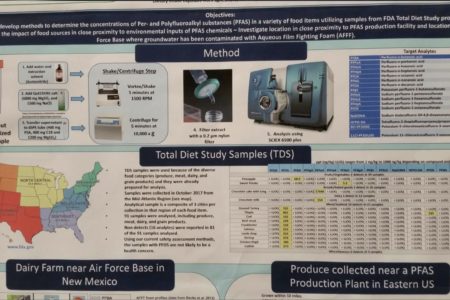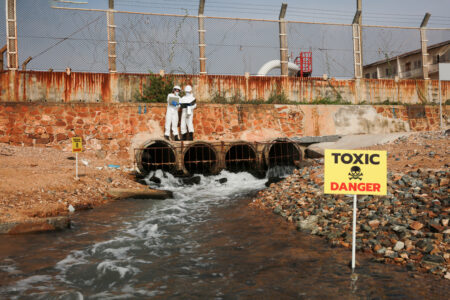
Share On Social!
Hazardous firefighting substances are tainting a wide range of foods, exposing numerous Latinos and Americans to harmful materials that do not break down in the body over time.
The FDA confirmed widespread per- and polyfluoroalkyl (PFAS) contamination this week. Their findings show high levels of the substance in meat, seafood, dairy, vegetable, and dessert products, according to the Environmental Working Group (EWG)
“Measuring PFAS concentrations in food, estimating dietary exposure and determining the associated health effects is an emerging area of science,” the FDA writes in a statement.
Additionally, FDA spokesperson Tara Rabin told the Associated Press that most contamination levels were “not likely to be a human health concern.”
Investigation Findings and Leaks
The agency’s initial findings illustrate the need for more significant bodies of PFAS contamination research, according to EWG.
In its investigation, the FDA tested for PFAS food contamination in eight states, including North Carolina (9.5% Latino), West Virginia (1.6%), Delaware (9.3%), and Kentucky (3.7%).
The results showed PFAS levels in:
- Half of the tested meat and seafood products
- Chocolate milk and chocolate cakes with icing
- Fruits, such as pineapple
- Vegetables, such as sweet potato
- Leafy greens grown 10 miles near a PFAS facility.
There was a wide range of contamination rates in these items. For example, in meat chemical concentrations went from 134 parts per trillion (ppt) to 865 ppt.
Another government agency’s health advisory numbers are far below those levels: the EPA recommends 70 ppt as the highest level acceptable.
At the annual Society of Environmental Toxicology and Chemistry’s European meeting in May, the FDA gave a presentation on their discoveries in investigating PFAS food contamination. Images from that presentation were taken and sent to the Environmental Defense Fund (EDF) and EWG, who made the information public.
On Monday, the FDA confirmed the images’ authenticity and announced a new website that will outline all of their findings.
“FDA scientists are at the forefront of developing new and more precise testing methods to measure PFAS concentrations in foods and we are working with states to build capacity for local testing laboratories,” the FDA writes. “New data will help inform FDA efforts to identify and prioritize activities to reduce PFAS in human and animal food.”
Concerns for Latinos and All Americans
Latinos, who already suffer inequity in food access and obesity, now face greater risks in their food purchasing choices.
 Worse, people of color are especially at risk, as they are a frequent buyer of many of the foods containing PFAS contamination, according to the Neilsen Group.
Worse, people of color are especially at risk, as they are a frequent buyer of many of the foods containing PFAS contamination, according to the Neilsen Group.
“Their survey [of 2,000 Americans] found multicultural shoppers spend 4% more on fresh groceries, including meat, bakery items, and seafood, than white non-Hispanics,” writes Elizabeth Crawford of FoodNavigator-USA.
The data showed that Latinos are more likely to purchase higher numbers of:
- Produce than whites and blacks
- Meats than whites
- Seafood than whites
More exposure to these chemicals can lead to more significant risks for harm.
Steps Toward Safe Food
The FDA’s recent action plan garnered the support of environmentalist groups. Still, these organizations urge for thorough research as soon as possible.
“We applaud FDA for getting the investigation started and recommend that, given these results, it reduce PFAS contamination in the food supply,” writes Tom Neltner, Chemicals Policy Director of EDF. “Specifically, the agency should test food more extensively, including for the forms of PFAS the agency currently allows to be used; identify the sources for high levels of PFAS by investigating the supply chain; and ensure that no PFAS is used because of [loopholes].”
The agency plans to form an internal working group that will work with state agencies and local testing facilities to continue its investigation into the contamination issue.
Additionally, the EPA announced its PFAS action plan in April. It included information about health advisory levels in water. One aspect of that plan is changing the rules companies follow when eliminating waste, which can pollute groundwater supplies.
You can get involved to speak up for a safer environment, too!
Submit a comment to the EPA today, urging them not to allow more pollution to enter into water supplies!
Editor’s Note: This article is part of a collaboration between Salud America! and the Hoffman Toxicant-Induced Loss of Tolerance (TILT) program at UT Health- San Antonio. To find out if you are TILTed due to exposure to everyday foods, chemicals, or drugs, take a self-assessment or learn more about TILT.
Explore More:
Chemical & Toxic ExposureBy The Numbers
1
Quick Survey
Can help you find out how chemically sensitive you are



